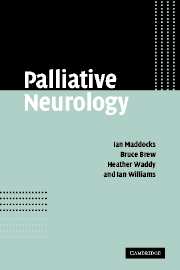Refine search
Actions for selected content:
2077 results for palliative
16 - Palliative Care
-
-
- Book:
- Gynaecological Oncology for the MRCOG
- Published online:
- 14 April 2018
- Print publication:
- 19 April 2018, pp 165-178
-
- Chapter
- Export citation
10 - Palliative|care
-
-
- Book:
- Practical Clinical Oncology
- Published online:
- 05 November 2015
- Print publication:
- 19 November 2015, pp 121-131
-
- Chapter
- Export citation

Palliative Neurology
-
- Published online:
- 08 January 2010
- Print publication:
- 17 November 2005
7 - Palliative care
-
-
- Book:
- Practical Clinical Oncology
- Published online:
- 23 December 2009
- Print publication:
- 24 January 2008, pp 83-92
-
- Chapter
- Export citation
three - Palliative care
-
- Book:
- Rethinking Palliative Care
- Published by:
- Bristol University Press
- Published online:
- 14 January 2022
- Print publication:
- 04 April 2007, pp 43-78
-
- Chapter
- Export citation
13 - Christopher Pallis
-
- Book:
- Anarchist Seeds Beneath the Snow
- Published by:
- Liverpool University Press
- Published online:
- 04 July 2017
- Print publication:
- 31 December 2006, pp 288-308
-
- Chapter
- Export citation
182 - Palliative Care
- from Section 3 - Treatment and Care
-
-
- Book:
- Cambridge Handbook of Psychology, Health and Medicine
- Published online:
- 05 June 2019
- Print publication:
- 16 May 2019, pp 651-652
-
- Chapter
- Export citation
25 - Palliative care
- from Part III - Working with specific units
-
-
- Book:
- Handbook of Liaison Psychiatry
- Published online:
- 10 December 2009
- Print publication:
- 24 May 2007, pp 592-616
-
- Chapter
- Export citation
Section I - Palliative Management
-
- Book:
- Palliative Neurology
- Published online:
- 08 January 2010
- Print publication:
- 17 November 2005, pp 1-2
-
- Chapter
- Export citation
16 - Palliative radiotherapy
- from SECTION V - THE ROLE OF ANTINEOPLASTIC THERAPIES IN PAIN CONTROL
-
-
- Book:
- Cancer Pain
- Published online:
- 08 October 2009
- Print publication:
- 23 June 2003, pp 279-310
-
- Chapter
- Export citation
Chapter 21 - Palliative Care
-
-
- Book:
- Seminars in Old Age Psychiatry
- Published online:
- 21 June 2019
- Print publication:
- 11 July 2019, pp 239-248
-
- Chapter
- Export citation
77 - Palliative care
- from Section 12 - Cancer and Palliative Care
-
-
- Book:
- Principles of Medicine in Africa
- Published online:
- 05 March 2013
- Print publication:
- 02 January 2013, pp 841-848
-
- Chapter
- Export citation
Palliative care
-
-
- Book:
- Hospital Surgery
- Published online:
- 06 July 2010
- Print publication:
- 16 February 2009, pp 587-590
-
- Chapter
- Export citation
58 - Palliative care
- from SECTION 4 - Procedure-Specific Care in Cardiothoracic Critical Care
-
-
- Book:
- Core Topics in Cardiothoracic Critical Care
- Published online:
- 05 July 2014
- Print publication:
- 13 March 2008, pp 425-430
-
- Chapter
- Export citation
16 - Palliative Care
-
-
- Book:
- Gynaecological Oncology for the MRCOG
- Published online:
- 14 April 2018
- Print publication:
- 19 April 2018, pp 165-178
-
- Chapter
- Export citation
Palliative care*
-
- Journal:
- Palliative & Supportive Care / Volume 15 / Issue 5 / October 2017
- Published online by Cambridge University Press:
- 12 January 2017, p. 625
-
- Article
- Export citation
22 - Palliative Medicine
-
-
- Book:
- Ethical Dilemmas in Emergency Medicine
- Published online:
- 05 November 2015
- Print publication:
- 20 October 2015, pp 315-328
-
- Chapter
- Export citation
4 - Palliative sedation:
-
-
- Book:
- Continuous Sedation at the End of Life
- Published online:
- 05 September 2013
- Print publication:
- 01 August 2013, pp 65-85
-
- Chapter
- Export citation
14 - Palliative care
-
-
- Book:
- Gynaecological Oncology for the MRCOG and Beyond
- Published online:
- 05 August 2014
- Print publication:
- 01 January 2011, pp 209-228
-
- Chapter
- Export citation
20 - Palliative radiotherapy
- from SECTION VII - THE ROLE OF ANTINEOPLASTIC THERAPIES IN PAIN CONTROL
-
-
- Book:
- Cancer Pain
- Published online:
- 06 July 2010
- Print publication:
- 12 October 2009, pp 379-398
-
- Chapter
- Export citation
